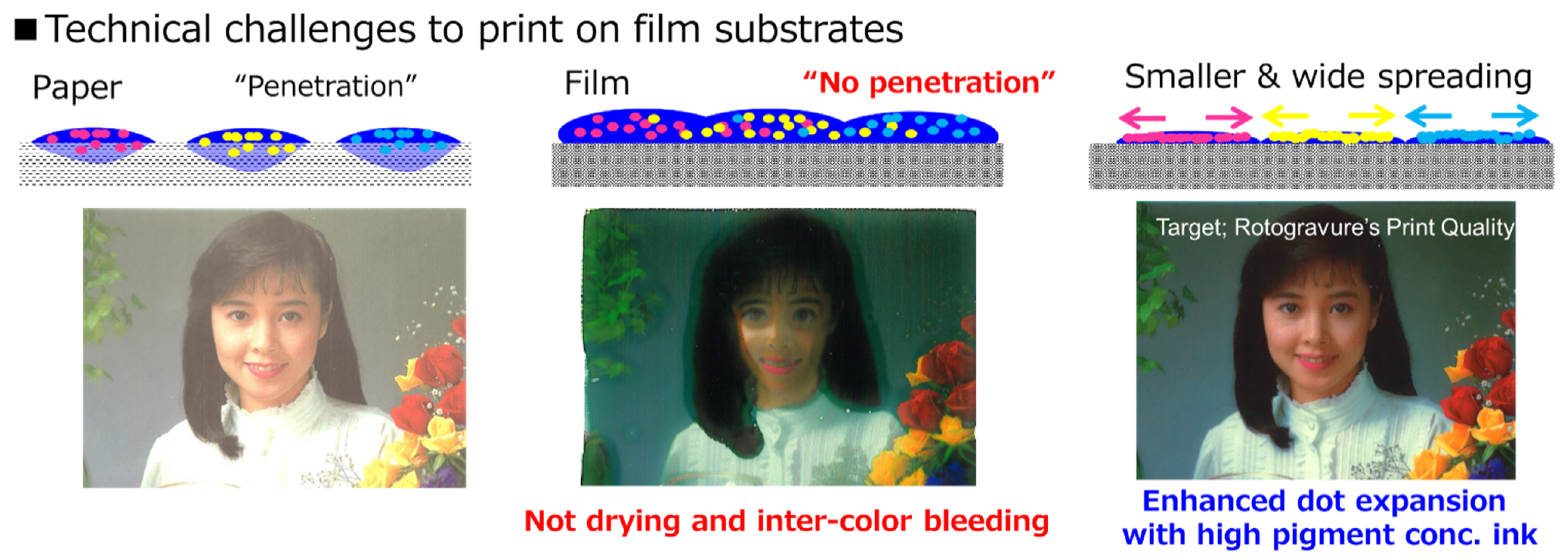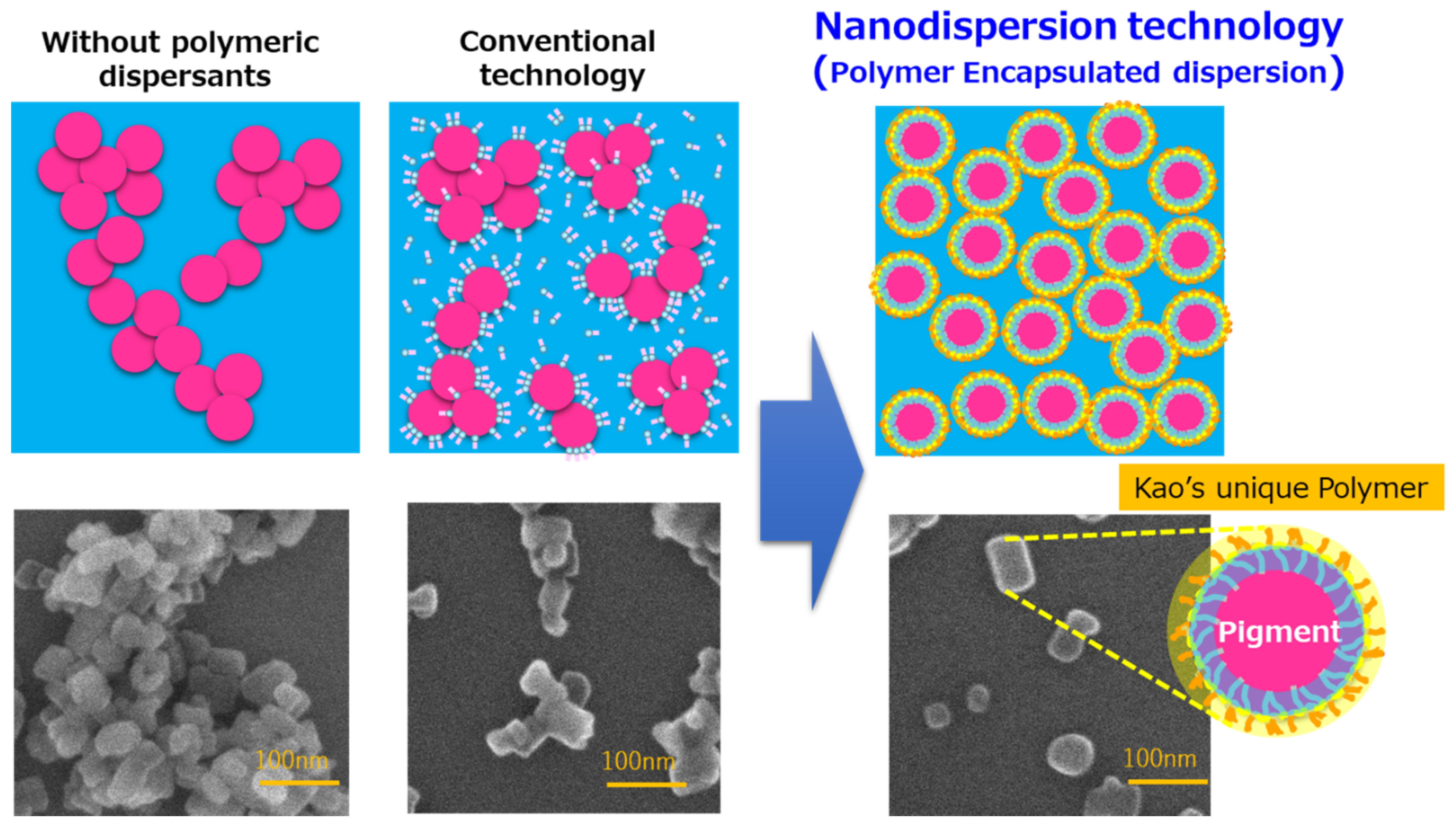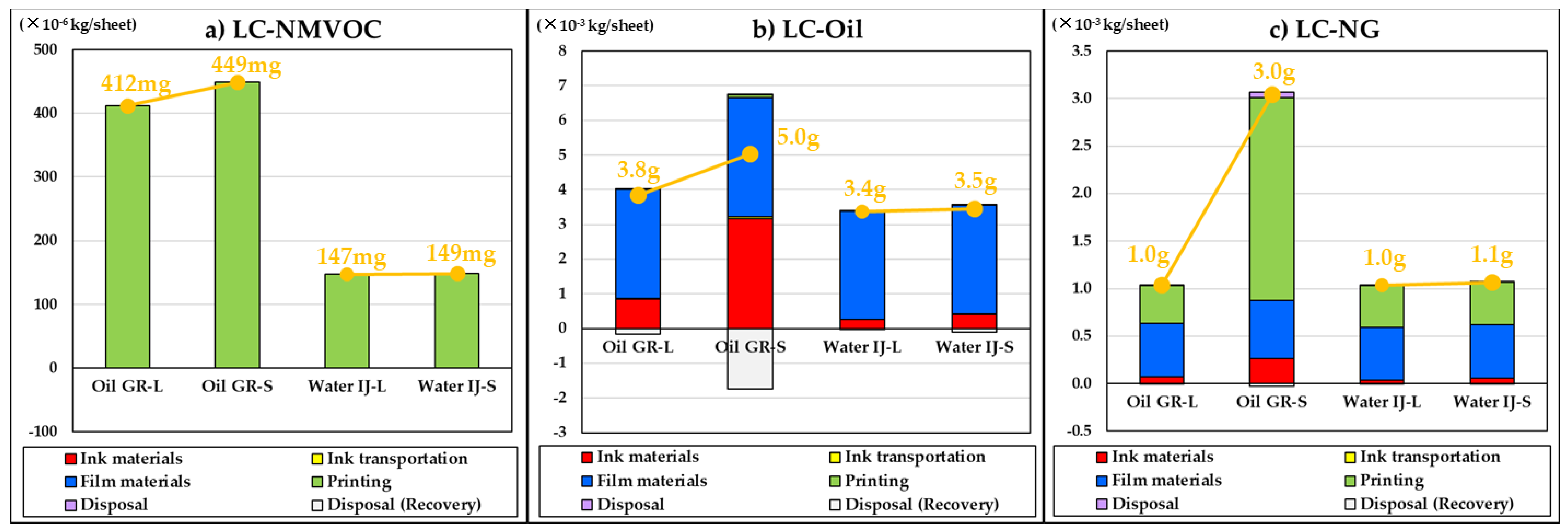Environmental Impact Assessment of Flexible Package Printing with the “LUNAJET®” Aqueous Inkjet Ink Using Nanodispersion Technology
Abstract
:1. Introduction
1.1. New Water-Based Ink LUNAJET® and Digital Inkjet Printing
1.2. Technology of the LUNAJET® Ink and the Inkjet Printer for Flexible Packages
1.2.1. Challenges in the Printing Process
1.2.2. Pigment Nanodispersion Technology
1.2.3. Precise Interfacial Control Technology
1.2.4. Summary of Ink Design Technologies for the Printing Process
2. Materials and Methods
2.1. Functional Units and System Boundaries
2.1.1. Targeted Products
2.1.2. Evaluation Scenario
2.1.3. Functional Unit
2.1.4. System Boundaries
2.2. Data Collection
2.2.1. Raw Material Procurement Stage
2.2.2. Printing Stage
2.2.3. Disposal Stage
2.3. Environmental Impact Assessment (Characterization) Method
2.3.1. Global Warming
2.3.2. Photochemical Oxidants
2.3.3. Fossil Fuel Consumption
3. Results
3.1. Results of Inventory Analysis
3.1.1. Life Cycle CO2 Emissions (LC-CO2)
3.1.2. Life cycle NMVOC Emissions (LC-NMVOC)
3.1.3. Life Cycle Crude Oil Consumption (LC-Oil)
3.1.4. Life Cycle Natural Gas Consumption (LC-NG)
3.2. Characterization Results
3.2.1. Global Warming
3.2.2. Photochemical Oxidants
3.2.3. Fossil Fuel Consumption
4. Discussion
4.1. Environmental Impact of Ink Composition and Printing Method
4.1.1. LC-CO2
4.1.2. LC-NMVOC
4.2. Sensitivity Analysis on Number of Ink Colors
4.2.1. LC-CO2 (2100 m2 Printing, per Film Package)
4.2.2. LC-NMVOC (2100 m2 Printing, per Film Package)
4.3. Impact Assessment
5. Conclusions
Author Contributions
Funding
Institutional Review Board Statement
Informed Consent Statement
Conflicts of Interest
References
- EU Commission. Circular Economy Package. Available online: https://ec.europa.eu/environment/circular-economy/first_circular_economy_action_plan.html (accessed on 28 December 2020).
- Clean Ocean Material Alliance, JP. Available online: https://cloma.net/english/ (accessed on 28 December 2020).
- Haruka, K. Effects of Package Changes and Product Redesign on Purchase: Differences among Types of Package Redesign. Jpn. Mark. J. 2019, 38, 95–110. [Google Scholar] [CrossRef]
- Hiroaki, I.; Naoto, O. Kachisiten No Package Design Senryaku. Jpn. Mark. J. 2010, 30, 31–43. [Google Scholar] [CrossRef]
- Toshio, A. Trends in Printing for Packaging in Overseas Markets-Technologies for Enhancing Product Values. J. Print. Sci. Technol. 2015, 52, 116–125. [Google Scholar] [CrossRef]
- Kao. Achieving Film Printing for Soft Packaging with World’s First Ink Technology? Development of Pigment Ink for Water-based Inkjets with Reduced Environmental Impact in VOC-less Design? New Entry in Industrial Printing Field. Available online: https://www.kao.com/jp/corporate/news/rd/2016/20160316_001/ (accessed on 28 February 2021).
- Gibbons, L. Sustainable Packaging Waste of Breath? Food Manuf. 2013, 88, 46–47. [Google Scholar]
- Pires, A.; Martinho, G.; Ribeiro, R.; Mota, M.; Teixeira, L. Extended Producer Responsibility: A Differential Fee Model for Promoting Sustainable Packaging. J. Clean. Prod. 2015, 108, 343–353. [Google Scholar] [CrossRef]
- Graedel, T.E. Streamlined Life Cycle Assessment; Prentice Hall: Upper Saddle River, NJ, USA, 1998. [Google Scholar]
- Sonneveld, K. The Role of Life Cycle Assessment as a Decision Support Tool for Packaging. Packag. Technol. Sci. 2000, 13, 55–61. [Google Scholar] [CrossRef]
- Shonfield, P.K.A.; Dumelin, E.E. A Life Cycle Assessment of Spreads and Margarines. Lipid Technol. 2005, 17, 199–203. [Google Scholar]
- Miah, J.H.; Griffiths, A.; McNeill, R.; Halvorson, S.; Schenker, U.; Espinoza-Orias, N.D.; Morse, S.; Yang, A.; Sadhukhan, J. Environmental Management of Confectionery Products: Life Cycle Impacts and Improvement Strategies. J. Clean. Prod. 2018, 177, 732–751. [Google Scholar] [CrossRef]
- Yamaguchi, Y. Development and Prospective Problems of Shampoo and Rinse. Today’s Development of Environment Sensitive Shampoo and Hair Treatment. Fragr. J. 2000, 28, 49–54. [Google Scholar]
- Smith, C. Flexible Packaging Stand-up Pouches, Pouches Gain from Eco-Concerns. Eur. Plast. News 2008, 35, 33. [Google Scholar]
- Barlow, C.Y.; Morgan, D.C. Polymer Film Packaging for Food: An Environmental Assessment. Resour. Conserv. Recycl. 2013, 78, 74–80. [Google Scholar] [CrossRef]
- Matsumoto, S. Efforts to Contribute to the Environment Using LCA at Ajinomoto Co., Inc. MRC News 2011, 45, 50–68. [Google Scholar]
- Bousquin, J.; Esterman, M.; Rothenberg, S. Life Cycle Analysis in the Printing Industry: A Review. Available online: http://scholarworks.rit.edu/books/93 (accessed on 28 December 2020).
- Jason, O.; Ellen, C.; Scott, C.; Tim, S. Environmental Metrics for Printers. ACM SIGMETRICS Perform. Eval. Rev. 2010, 37, 79–83. [Google Scholar] [CrossRef]
- Research Laboratory for IDEA; Research Institute of Science for Safety and Sustainability; National Institute of Advanced Industrial Science and Technology (AIST); Sustainable Management Promotion Organization (SuMPO). LCI database IDEA version 2. Available online: http://www.idea-lca.jp/index.html (accessed on 28 February 2021).
- Ecoinvent. Ecoinvent-The World’s Most Consistent & Transparent Life Cycle Inventory Database. Available online: https://www.ecoinvent.org/home.html (accessed on 28 February 2021).
- Blanchard, D. Ecology and the Environment and How They Will Affect the Ink Industry. Surf. Coat. Int. 1997, 80, 476–478. [Google Scholar] [CrossRef]
- Murauchi, K. Environmental Problems and Converting Aiming for Green Converting. Convertech 2000, 28, 27–29. [Google Scholar]
- Oki, Y.; Sasaki, H. Social and Environmental Impacts of Packaging (LCA and Assessment of Packaging Functions). Packag. Technol. Sci. 2000, 13, 45–53. [Google Scholar] [CrossRef]
- Tolle, D.A.; Evers, D.P.; Vigon, B.W.; Sheehan, J.J. Streamlined LCA of Soy-Based Ink Printing. Int. J. Life Cycle Assess. 2000, 5, 374–384. [Google Scholar] [CrossRef]
- Uchida, H. LCA of Packaging Material with Gravure Printing. J. Packag. Sci. Technol. Jpn. 2007, 16, 397–404. [Google Scholar]
- Fukumori, H. Environmental Impact Assessment of Gravure Printed Packaging Materials LCA Comparison of Water-based Printed Packaging Materials and Oil-based Printed Packaging Materials. Convertech 2007, 35, 35–43. [Google Scholar] [CrossRef]
- Bohlmann, G.M. Biodegradable Packaging Life-Cycle Assessment. Environ. Prog. 2004, 23, 342–346. [Google Scholar] [CrossRef]
- Hasegawa, Y.; Miyazawa, Y. Development of Eco-Friendly Packaging. Packag. Tech. 2015, 53, 447–450. [Google Scholar]
- Kunihiro, T. Development of “BIOMATECH, DNP Biomass Plastic Packaging Materials” to the Paper Containers. Packag. Tech. 2015, 53, 458–462. [Google Scholar]
- Omura, C.; Uchimura, G. Eco-Friendly Paper Packaging Barrier Material “SHIELDPLUS”. Packag. Tech. 2018, 56, 632–636. [Google Scholar]
- Mitsui Chemicals Tohcello, Inc. Freshness-Keeping Film: SPASH. Packag. Tech. 2014, 52, 314–318. [Google Scholar]
- Wikstroem, F.; Williams, H.; Verghese, K.; Clune, S. The Influence of Packaging Attributes on Consumer Behavior in Food-Packaging Life Cycle Assessment Studies—A Neglected Topic. J. Clean. Prod. 2014, 73, 100–108. [Google Scholar] [CrossRef]
- Joachimiak-Lechman, K.; Selech, J.; Kasprzak, J. Eco-Efficiency Analysis of an Innovative Packaging Production: Case Study. Clean Technol. Environ. Policy 2019, 21, 339–350. [Google Scholar] [CrossRef] [Green Version]
- Kawaguchi, F.; Egawa, T.; Kunii, S.; Kozake, K.; Okada, T.; Shibata, M.; Itsubo, N. Environment assessment of water-based inkjet printing for flexible package. In Proceedings of the 15th Meeting of the Institute of Life Cycle Assessment, Tokyo, Japan, 10–12 March 2020; pp. 160–161. [Google Scholar]
- Strecker, T.; Lesage, P. Environmental Life Cycle Assessment of Commercial Analog and Digital Printing. In Proceedings of the NIP & Digital Fabrication Conference, 2010 International Conference on Digital Printing Technologies, Austin, TX, USA, 19–23 September 2010; pp. 97–101. [Google Scholar]
- International Organization for Standardization. ISO 14040:2006 Environmental Management-Life Cycle Assessment-Principles and Framework; International Organization for Standardization: Geneva, Switzerland, 2006. [Google Scholar]
- Sato, T. Inkjet Printing Technology in Flexible Package Printing Market. Jpn. Soc. Imaging Eng. 2016, 572–577. [Google Scholar] [CrossRef]
- Yasuhiro, U. Inkjet Ink Development for Films. Print. Mag. 2016, 99, 7–23. [Google Scholar]
- Egawa, T.; Kozake, K. Development of Eco-Friendly Water-Based Inkjet Ink for Flexible Packaging Film. Soft Drink Gijyutsusiryou 2019, 188, 111–118. [Google Scholar]
- Hiroshi, O. Basis of Variance Theory. Coloring Mater. 2004, 77, 7. [Google Scholar]
- Kitahara, F.; Furusawa, K. Saishin Koroido Kagaku; Kodansha Scientific Ltd.: Tokyo, Japan, 1990. [Google Scholar]
- Fuji Keizai. Overview of the Functional Ink Market; Fuji Keizai Co., Ltd.: Tokyo, Japan, 2016. [Google Scholar]
- Yano Research Institute. High-Performance Packaging Material Market Outlook and Strategy; Yano Research Institute Ltd.: Tokyo, Japan, 2019. [Google Scholar]
- Schrijvers, D.L.; Loubet, P.; Sonnemann, G. Critical Review of Guidelines Against a Systematic Framework with Regard to Consistency on Allocation Procedures for Recycling in LCA. Int. J. Life Cycle Assess. 2016, 21, 994–1008. [Google Scholar] [CrossRef]
- Schaubroeck, T.; Gibon, T.; Igos, E.; Benetto, E. Sustainability Assessment of Circular Economy Over Time: Modelling of Finite and Variable Loops & Impact Distribution Among Related Products. Resour. Conserv. Recycl. 2021, 168, 105319–105342. [Google Scholar] [CrossRef]
- LCA Society of Japan. LIME2 Library. Available online: https://lca-forum.org/english/news/index.html#lime2 (accessed on 28 February 2021).
- Itsubo, N.; Inaba, A. LIME 3 (Life Cycle Impact Assessment Method Based on Endpoint Modeling); Maruzen Publishing: Tokyo, Japan, 2018. [Google Scholar]









| No. | Name | Contents |
|---|---|---|
| Scenario 1 | Analog printing Oil-based ink/gravure printing system 21,000 m2 Print (Oil GR-L) | Inks: 6 colors (oil-based), printing plates: 6 Ink application: 5.4 g/m2 Film length: 20,000 m, film width: 1.05 m Power for printing: 270 kWh Film loss at startup: 210 m2 (200 m) Ink loss: 6 kg/color (CMYK), 10 kg/color (special color) Ink volatile component: atmospheric emission Film loss and ink loss: incineration (including heat recovery) |
| Scenario 2 | Analog printing Oil-based ink/gravure printing system 2100 m2 Print (Oil GR-S) | Inks: 6 colors (oil-based), printing plates: 6 Ink application: 5.4 g/m2 Film length: 2000 m, film width: 1.05 m Power for printing: 29 kWh Film loss at startup: 210 m2 (200 m) Ink loss: 6 kg/color (CMYK), 10 kg/color (special color) Ink volatile component: atmospheric emission Film loss and ink loss: incineration (including heat recovery) |
| Scenario 3 | Digital printing Water-based ink/inkjet printing system 21,000 m2 Print (Water IJ-L) | Inks: 6 colors (Water-based), no printing plate Ink application: 4.8 g/m2 Film length: 20,000 m, film width: 1.05 m Power for printing: 565 kWh Film loss at startup: 21 m2 (20 m) Ink loss: 1 kg/color (CMYK, special color) Ink volatile component: atmospheric emission Film loss and ink loss: incineration (including heat recovery) |
| Scenario 4 | Digital printing Water-based ink/inkjet printing system 2100 m2 Print (Water IJ-S) | Inks: 6 colors (Water-based), no printing plate Ink application: 4.8 g/m2 Film length: 2000 m, film width: 1.05 m Power for printing: 57 kWh Film loss at startup: 21 m2 (20 m) Ink loss: 1 kg/color (CMYK, special color) Ink volatile component: atmospheric emission Film loss and ink loss: incineration (including heat recovery) |
| Stage | Process/Flows | Database | Remarks | ||
|---|---|---|---|---|---|
| Raw material procurement | Ink | Pigments | IDEAv2 | Ring intermediates, synthetic dyes, organic pigments | |
| VOC | IDEAv2 | Ethyl acetate | representative | ||
| Water | IDEAv2 | Pure water, ion exchange membrane method | |||
| Ink transportation | IDEAv2 | Trucking service, 10-ton vehicle, 75% load rate | 485 km | ||
| Film | IDEAv2 | Plastic film production | |||
| Printing | Power | IDEAv2 | Tokyo Electric Power, 2015 | ||
| Printing plate | Cu | IDEAv2 | Crude copper production | ||
| Ni | IDEAv2 | Metal nickel production | |||
| Cr | IDEAv2 | Chromic acid production | |||
| Disposal | Incineration | Ink | IDEAv2 | Incineration services, industrial waste, waste oil | |
| Printed materials | IDEAv2 | Incineration services, industrial waste, waste plastics | |||
| Landfill | Cu, Ni, Cr | IDEAv2 | Industrial waste treatment, scrap metal | ||
| Recovered energy | Heavy oil | IDEAv2 | Production of heavy oil A | ||
| No. | Name | Contents |
|---|---|---|
| Scenario 5 | Digital printing Oil-based ink/inkjet printing system 1100–55,000 m2 (Oil IJ) | Inks: 6 colors (oil-based), no printing plates Ink application: 5.4 g/m2 Film length: 1000–50,000 m, film width: 1.05 m Film loss at startup: 21 m2 (20 m) Ink loss: 1 kg/color (CMYK, special color) Ink volatile component: atmospheric emission Film loss Ink loss: incineration (including heat recovery) |
| Area of Environmental Impact | Inventory Used |
|---|---|
| Climate change | CO2, CH4, N2O |
| Air pollution (urban areas) | SO2, NOX, PM10 |
| Photochemical oxidants | NOX, NMVOC |
| Resource consumption | Oil, Coal, NG |
| Water consumption | Water (groundwater) |
Publisher’s Note: MDPI stays neutral with regard to jurisdictional claims in published maps and institutional affiliations. |
© 2021 by the authors. Licensee MDPI, Basel, Switzerland. This article is an open access article distributed under the terms and conditions of the Creative Commons Attribution (CC BY) license (https://creativecommons.org/licenses/by/4.0/).
Share and Cite
Kozake, K.; Egawa, T.; Kunii, S.; Kawaguchi, H.; Okada, T.; Sakata, Y.; Shibata, M.; Itsubo, N. Environmental Impact Assessment of Flexible Package Printing with the “LUNAJET®” Aqueous Inkjet Ink Using Nanodispersion Technology. Sustainability 2021, 13, 9851. https://doi.org/10.3390/su13179851
Kozake K, Egawa T, Kunii S, Kawaguchi H, Okada T, Sakata Y, Shibata M, Itsubo N. Environmental Impact Assessment of Flexible Package Printing with the “LUNAJET®” Aqueous Inkjet Ink Using Nanodispersion Technology. Sustainability. 2021; 13(17):9851. https://doi.org/10.3390/su13179851
Chicago/Turabian StyleKozake, Katsuyuki, Tsuyoshi Egawa, Satoshi Kunii, Hiroki Kawaguchi, Toru Okada, Yushi Sakata, Manabu Shibata, and Norihiro Itsubo. 2021. "Environmental Impact Assessment of Flexible Package Printing with the “LUNAJET®” Aqueous Inkjet Ink Using Nanodispersion Technology" Sustainability 13, no. 17: 9851. https://doi.org/10.3390/su13179851
APA StyleKozake, K., Egawa, T., Kunii, S., Kawaguchi, H., Okada, T., Sakata, Y., Shibata, M., & Itsubo, N. (2021). Environmental Impact Assessment of Flexible Package Printing with the “LUNAJET®” Aqueous Inkjet Ink Using Nanodispersion Technology. Sustainability, 13(17), 9851. https://doi.org/10.3390/su13179851







